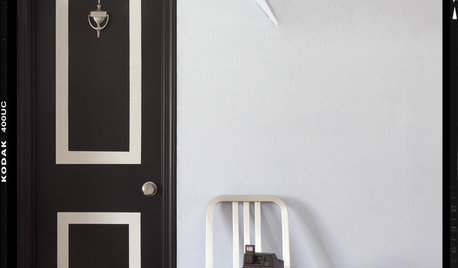Can Hypertufa set up in a latex mould?
Bleedfoot
18 years ago
Related Stories

DOORSHow to Jazz Up a Solid-Front Door
Remake a door with new paint, molding, wallpaper, hardware and more
Full Story
KITCHEN DESIGNHouse Planning: How to Set Up Your Kitchen
Where to Put All Those Pots, Plates, Silverware, Utensils, Casseroles...
Full Story
STORAGEBookcases and Floating Shelves That Break the Mold
Linear horizontal shelves have their place, but you can also get creative. Here are some ideas to spark inspiration
Full Story
REMODELING GUIDESCrown Molding: Is It Right for Your Home?
See how to find the right trim for the height of your ceilings and style of your room
Full Story
KITCHEN DESIGN9 Molding Types to Raise the Bar on Your Kitchen Cabinetry
Customize your kitchen cabinets the affordable way with crown, edge or other kinds of molding
Full Story
REMODELING GUIDESFrame Your Views With Great Moldings and Casings
How to Work With Trim to Give Your Space Depth and Interest
Full Story
TRIMMolding: Add Texture by Detailing Your Detail
Take the Architectural Accent to the Next Level with These Extra Elements
Full Story
BUDGET DECORATINGThe Cure for Houzz Envy: Living Room Touches Anyone Can Do
Spiff up your living room with very little effort or expense, using ideas borrowed from covetable ones
Full Story
KITCHEN DESIGNThe Cure for Houzz Envy: Kitchen Touches Anyone Can Do
Take your kitchen up a notch even if it will never reach top-of-the-line, with these cheap and easy decorating ideas
Full Story
GREAT HOME PROJECTSHow to Bring Out Your Home’s Character With Trim
New project for a new year: Add moldings and baseboards to enhance architectural style and create visual interest
Full Story





tufaenough
BleedfootOriginal Author
Related Professionals
Essex Landscape Architects & Landscape Designers · Southfield Landscape Architects & Landscape Designers · Wixom Landscape Architects & Landscape Designers · Finneytown Landscape Architects & Landscape Designers · Anderson Landscape Contractors · Edmond Landscape Contractors · Waterbury Landscape Contractors · East Hanover Landscape Contractors · Estelle Landscape Contractors · Fort Mill Landscape Contractors · Kaneohe Landscape Contractors · Lady Lake Landscape Contractors · Ringwood Landscape Contractors · Rockland Landscape Contractors · New Carrollton Landscape Contractorstufaenough
BleedfootOriginal Author
Herb
BleedfootOriginal Author
tufaenough
BleedfootOriginal Author
HowieDoin
paws4pets
gottatufa
BleedfootOriginal Author
HowieDoin
gottatufa